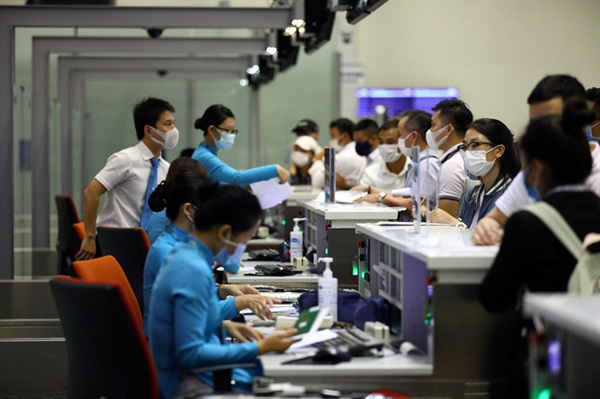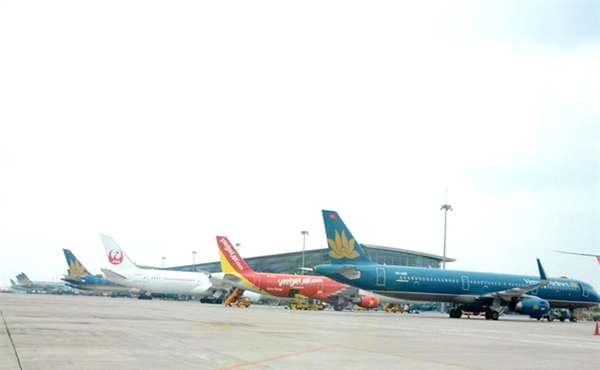 |
| Vietnam Airlines check-in counter at Noi Bai International Airport, Hanoi. — VNA/VNS Photo Huy Hung |
The country has recently decided to reopen international flights to and from six Asian destinations – Japan, South Korea, China, China’s Taiwan, Laos and Cambodia – six months after the country closed its border on March 22 to battle the spread of the coronavirus.
According to the aviation authority, there will be nine total inbound flights a week landing in Hanoi and HCM City.
National flag carrier Vietnam Airlines and budget airline Vietjet Air will conduct four flights to Hanoi every Tuesday, Wednesday, and Thursday with a maximum of 1,304 seats, and five flights to HCM City on Tuesday, Wednesday, Thursday and Friday with a maximum of 1,290 seats.
Earlier on September 11, the agency sent letters to their Japanese, Chinese, Taiwanese and South Korean counterparts detailing the plans.
The Asian partners all agreed with Vietnam’s plan.
China designated China Southern Airlines (code CZ) to operate the Guangzhou-HCM City route with one flight per week.
Japan designated Japan Airlines (code JL) and All Nippon Airways (NH) to alternately operate the Tokyo to Hanoi and HCM City route on a weekly basis, with the frequency of one flight per week per route.
China’s Taiwan selected China Airlines (code CI) and Eva Air (BR) to run the Taipei to Hanoi and HCM City route with the frequency of one flight per week per route.
South Korean airlines are still working on a plan to submit to the Vietnamese authority.
The aviation authority also proposed tweaks to flights between Vietnam and Laos and Cambodia based on the request of the Vietnamese foreign ministry and the two neighbouring countries’ authorities.
Accordingly, Vietnam Airlines will operate the Phnom Penh-HCM City route (instead of Can Tho originally) and Vientiane-Hanoi (instead of Van Don).
Requirements
The aviation authority has also submitted entry procedures for foreign arrivals on international flights.
Airlines are asked to only process bookings for passengers who provide all necessary information – including the names and phone numbers of the passengers’ contacts in Vietnam, address and phone number of the quarantine facility they will stay in, and the phone number of the host organisation who will receive the passengers at the airport.
Passengers must produce documents proving they have been allowed to quarantine in facilities such as diplomatic representative’s buildings, factories, business headquarters, hotels or other similar accommodations, or centralised quarantine facilities managed by the military.
To this end, local governments in Vietnam must publicise the list of all certified quarantine facilities in their jurisdiction as well as transportation services that can bring passengers to the quarantine facilities, in addition to the cost of each quarantine option and coronavirus testing, according to the aviation authority.
All localities must be uniform in their reception of foreign entries and not introduce separate procedures for flights that have already got permits to operate, the agency said.
During check-in procedures, the airlines must ask passengers to present their passport, entry visa, and proofs of a negative SARS-CoV-2 PRC test obtained three days prior to boarding.
The negative test must be certified by the Vietnamese diplomatic representative in their country or locality.
Before boarding, passengers must wear masks, install the Vietnamese contact-tracing app Bluezone and the Vietnam Health Declaration app on their mobile devices, and fill out the health forms.
Airlines must carry out temperature checks and deny boarding for anyone with a temperature of more than 37.5 degrees Celsius.
Vietnamese and foreign airlines can only complete flight procedures for passengers with valid visas.
Airlines are told to monitor the health of the flight crewmembers after arrival into Vietnam, if the members show no signs of COVID-19 after 48 hours they could continue to work on other flights.
Currently, permitted entries to Vietnam are limited to foreign investors, business executives, experts, highly skilled workers, diplomats, international students – and their family – along with returning Vietnamese and their relatives.
International tourists are still not allowed in yet.
Earlier in a cabinet meeting, Prime Minister Nguyen Xuan Phuc asked for higher frequency of international commercial flights with the details to be approved by Deputy Prime Minister Vu Duc Dam, who heads the National Steering Committee for COVID-19 Prevention and Control, and Deputy Prime Minister and Minister of Foreign Affairs Pham Binh Minh.
Vietnam Airlines and Vietjet have registered with the aviation authority to conduct these flights from September 21 however as authorities have not fully fleshed out screenings, entry and quarantine protocols, the flights have not been implemented.
Vietnam Airlines has only carried out a one-way flight bringing 60 passengers from Vietnam to Japan last Saturday. VNS

Passengers must spend 6 days at concentrated quarantine centers after entering VN
With two continuous tests of negative results after their entry, those who enter Vietnam to work for a period of over 14 days can go home or to their accommodations for self-isolation, according to the latest Ministry of Health’s temporary guide.

Safety first when reopening international flights
Doctor Luong Hoai Nam, an aviation expert, talks to VietnamPlus online newspaper about measures to ensure the efficiency of Vietnam’s resumption of international flights.